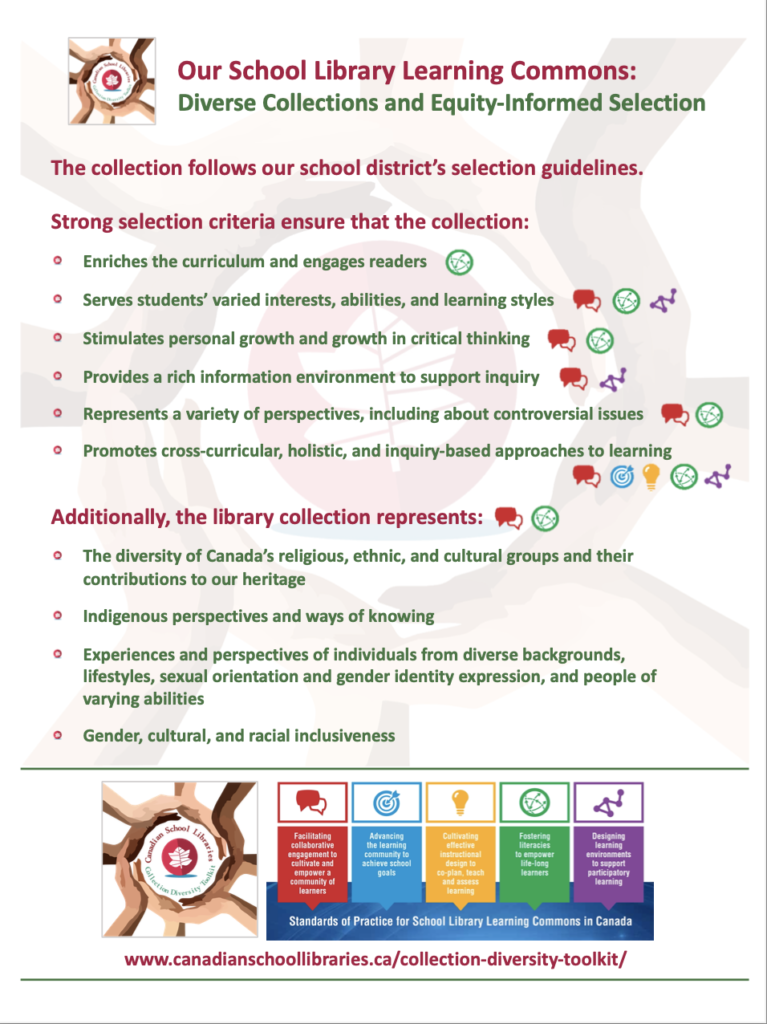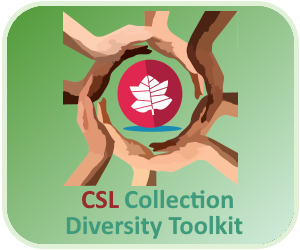 | 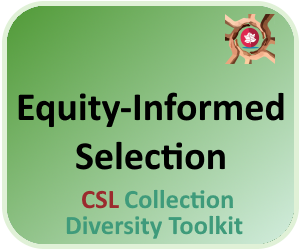 | 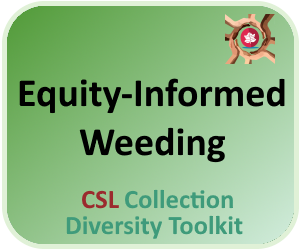 | 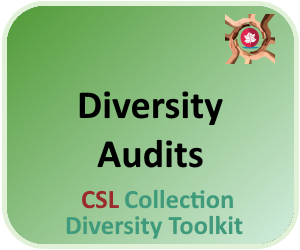 | 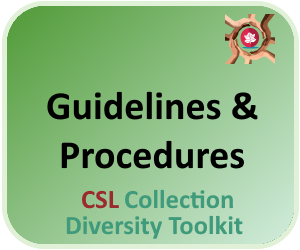 | 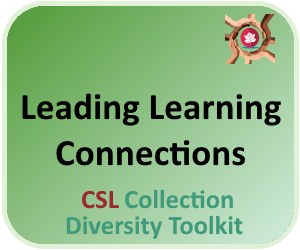 | 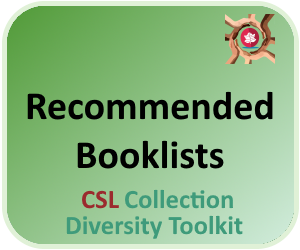 |

Collection Diversity: Addressing Leading Learning Standards
Key Questions
- How does developing diverse collections exemplify the best in school library learning commons practice?
- What are the connections to national standards?
- How can the Leading Learning framework help our learning commons team develop a plan for diverse collection development?
Canadian School Libraries is based on the vision that library learning commons approaches advance learning potential and school wide improvement. Our mission is to assist schools in working toward excellence of school library learning commons teaching and learning approaches and facilities to prepare students in Canada with skills and opportunities for learning today and into the future.
The collection diversity toolkit has been developed to support the daily work of school library professionals to build excellent library learning commons environment, resources and programs. This important work is guided by Leading Learning: Standards of Practice for School Library Learning Commons in Canada. The development of the best diverse collections to support teaching and learning is woven throughout the standards as exemplified in a selected exemplar from each standard below.
“Whereas the focus of the library program in the past was on building strong collections of resources and assisting users to find and use them effectively, the goal now is to build learning communities and make connections among learners, thus facilitating knowledge creation in the school community.”
Leading Learning: Standards of Practice for School Library Learning Commons in Canada

It takes teamwork to develop excellent diverse school library collections. School library professionals have the training and expertise to apply equity-informed selection criteria to weeding and collection development, conduct diversity audits and source best resources; however it takes the entire school community working collaboratively to address the specific diverse needs and academic goals of each school. The collaborative building of diverse collections is a key component of a successful school library learning commons vision.
Sample Exemplars: Vision for Learning – LLC builds learning communities and is responsive to evolving school, district and global changes.
“Librarians are extremely good at disseminating information along with curating excellent collections. Their worth is indisputable. Having an excellent learning commons website that is navigable and explains the curated collections is a gift to patrons. Offering digital resources that help support the academic needs of a community is vital. Providing cool lists and ways to access materials that are open access is part of what we do at our library learning commons.”
Pippa Davies (2020)
Ontario teacher-librarian Caroline Freibauer, editor of The Teaching Librarian (Ontario School Library Association magazine) and member of Canadian School Libraries (CSL) Board of Directors and CSL Journal Editorial Board, reached out to several education and library thinkers for their thoughts “through a library lens” regarding UNESCO’s Education in a post-COVID world: Nine ideas for public action. Responses were generous and thought provoking. Includes list of related references.
Freibauer, C. (2021). UNESCO’s Nine Ideas for Education. Canadian School Libraries Journal 5(2).
Focus Questions for Planning:
- How are staff collaborative partners in building a diverse, inclusive LLC collection?
- How is student voice incorporated into building collections that address all needs, abilities and interests?
- How is parent/community voice incorporated into collection diversity planning?

The CSL Collection Diversity Toolkit will help school library professionals ensure that the actions they take are directly linked to school and district goals and initiatives. Crafting excellent diverse collections and designing engaging learning experiences with these resources is key to planning for school wide improvement through the school library learning commons.
These questions developed by Janine Gleeson helped her to consider ways she could advance the LLC to address school needs and goals:
- How can I best support my school community?
- How have the needs of my school community changed?
- How can I connect to students and staff?
- How can I make the most impact this year?
- What is important to my school community and/or district?
A secondary teacher-librarian in the Surrey, British Columbia, School District shares superb specific and targeted LLC goals founded on the Canadian School Libraries (CSL) document, Leverage Your LLC: Pandemic Partner for Learning and the inquiry question “How can schools maintain critical LLC benefits during pandemic times?”. Includes web site example, growth indicators, actions, process, photos.
Gleeson, J. (2021). Goal Setting with CSL: An Informed Approach. Canadian School Libraries Journal 5(1).
Focus Questions for Planning:
- Is the LLC collection planning and district policy articulated in the school development plan?
- Is planning for collection diversity re-visited yearly when school planning is discussed with all staff or departments?
- How does the school library professional utilize collection data and other statistics to inform diverse collection planning?

One of the purposes of a diverse collection is to provide a rich information environment to support inquiry learning. The collection must also provide opportunities for differentiating learning experience for students with multiple learning styles and abilities. Ensuring differentiated content as well as approaches and processes is dependent on the quality of diverse collections.
Sample Exemplar: Differentiated Learning – Learning experiences support the personalization of learning for all learners.
Follow this Ontario teacher-librarian as she describes and reflects upon the pedagogical and practical challenges and successes of co-planning and designing maker learning with students, leading to the creation of “Genius Carts”. Links to illustrate practice are shared throughout the paper.
“If we approached our open-making program from an inquiry stance, would students begin to develop not only maker skills but an interest in learning and asking questions about making? Would students see making as a stepping stone to inquiry or inquiry as a stepping stone to making? What connections might be discovered between inquiry-based learning and the maker movement?”
Beth Lyons (2020)
Lyons, B. (2020). Maker. Space. Inquiry. Place. What might be the connection? Paper presented at the Treasure Mountain Canada 6 Symposium, Toronto, Canada.
Focus Questions for Planning:
- Are selection criteria visited regularly pre-during-and-post co-planned learning experiences to identify resources that work and gaps that need attending to?
- Does the collection provide a rich information environment to support inquiry?
- How does collection planning support differentiated learning?

The LLC leads school wide literacy development by engaging readers, teaching and supporting multiple literacies in partnership with the entire school community. The diversity collection toolkit helps school library professions to ensure that students and teachers have the best possible print, digital, human and physical resources accessible to them 24/7.
Sample Exemplar: Cultural Literacy – LLC program contributes to the co-creation of cultural literacy.
This article by Rabia Khokhar provides insight and direction in moving from books depicting a single story Muslim narrative to the values and norms of positive and authentic cultural representation, and in doing so disrupt stereotypes that can reinforce Islamophobia. Ideas for elementary school students to think critically and challenge stereotypes are shared through class and book club collaboration examples. Includes resources for teachers and critical checklist for assessing books with Muslim characters.
Khokhar, R. (2019). The Power of Stories: Learning from Complex Characters to Counter Islamophobia. ETFO Voice (Winter 2019).
Focus Questions for Planning
- Does the collection support all curriculum, deepen critical thinking and engage readers?
- Does the collection address principles of equity and diversity in the range of resources available?
- Does the collection recognize and respect Indigenous knowledge and ways of knowing of the First Nations, Métis and Inuit peoples?
- Is collection content appropriate for the intended age level?

The Collection Diversity Toolkit will help school library professionals to work towards growth of every theme in this important standard. In order to build excellent learning environments to support participatory learning the foundations must be solidly founded on equity-informed selection and guidelines.
An elementary British Columbia teacher-librarian focuses on collection development after re-designing the LLC with aid from a district grant. The process was guided with resources from BCTF Teacher Inquiry and Leading Learning. Student input and need led to selecting sensory/audio resources, expanding learning experiences for all. Includes reflections, illustrations and resource examples.
Cordeiro Lutz, M. (2020). Developing an Inclusive Collection with Sensory and Audiobooks. Canadian School Libraries Journal 4(3). Retrieved from https://journal.canadianschoollibraries.ca/developing-an-inclusive-collection-with-sensory-and-audiobooks/
Focus Questions for Planning
- Are the resources in the collection the “best resources for best learning in the best format”?
- Does the collection represent experiences and perspectives of individuals from diverse backgrounds, lifestyles, sexual orientation and gender identity or expression, and people of varying abilities?
- How does the physical and digital collection address accessibility for all?
- How does collection diversity support student well-being in the LLC?

 |  |  |  | ||
 |  |  |

